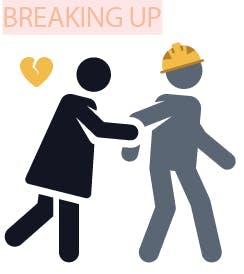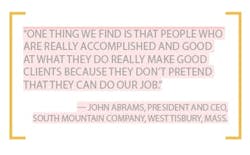How Builders Can Avoid Difficult Clients
You’ve had clients like these: The ones who hid nanny cameras on the jobsite to surveil your crews, or walked around your project during framing with a level and left orange sticky notes on the studs they wanted you to do over.
But there are worse customers. Clients who believe a new house means a perfect house. If anything goes wrong, they’re always right. Take on these customers from hell and your company could be sued out of existence, which, as one builder interviewed for this story explains, is happening to a long-time builder acquaintance of his in the Northeast because that builder didn’t heed the warning signs before taking on a client who could never be satisfied.
Read More
To learn more about novel ways other custom home builders manage their customers' expectations, check out "Keep Their Dream House From Becoming Your Nightmare"
For recommendations about how builders can get a firmer hold on the reins of the builder/client relationship, look at "The Customer Really Wants You to Be Right"
Custom home builders share how they get their clients on the same page Synching Great Expectations
To get an accurate read on people, custom builders often need to play psychologist. Vetting prospects and choosing your customers can be part art and part skill, honed through years of wisdom learned from past mistakes. But intuition also plays a role. Avoiding the nightmare client can be as basic as trusting your gut instinct. Some builders say they can tell within an hour of meeting a prospect whether they will take them on or cut them loose.
Entering a Relationship
For instance, Brian Bailey, of Bailey Homes, in Austin, Texas, says he will never accept a client that he wouldn’t want to invite into his own home. “If I’m around somebody that I wouldn’t enjoy having come over to my house to have dinner, then I wouldn’t consider them as a client,” he says.
Steve Bronstein, president of Cornerstone Homes and Design, in Riverview, Fla., activates his trust antenna when he meets prospects. “I have to determine how trusting the client is,” he says. “If there are inclinations that they are not trusting, I’m likely to bolt because my attitude is, if you show me that you don’t trust me, I know I can’t trust you.”
Dallas builder John Sebastian notes that when prospects interview him to determine whether they should hire Sebastian Construction Group, he’s also auditioning them. As Sebastian and his team meet prospects at their home, place of work, or at a restaurant, they’re watching how that person treats other people. Does he or she respect the receptionist, the help, waitstaff, coworkers? “How they treat their receptionist is probably how they treat everybody,” Sebastian says.
Considering that a custom home project can run two years or longer, Tim Hensley, president of Hensley Custom Building Group, in Loveland, Ohio, sizes up prospects by asking himself if he would go into business with these people. “That’s what you are doing when you’re building somebody a home,” Hensley says. “We only do 10 to 14 homes a year, so it’s a personal relationship between me, my team, and my clients. So one of the first things we look for is how will we get along as a partnership in building your home.” Also, he gravitates toward prospects who are similar to the good clients the firm previously built homes for, as Hensley uses them for referrals.
Bailey adds that picking a custom home client is akin to establishing what possibly could be a life-long relationship. “You’re not finished with the client when the house is finished. You’re in that relationship for as long as they own that home,” he says. “So why risk building a house for somebody who you know from the outset is not going to give you a good referral.”
Early Warnings: Heed Them
Follow your gut and don’t ignore the early warning signs. In other words, don’t overestimate your management ability to smooth out a troubled relationship. “We used to think, long ago, ‘Oh man, that’s all right, we can fix this,’” says John Abrams, president and CEO of South Mountain Company, in West Tisbury, Mass. “Nothing could be further from the truth. If the indicators are there early on, they’re not going to get better. In fact, they tend to get worse.”
How To Break Up with Tough Customers
Courtesy Flaticon.com
In interviews for this article, “marriage” was among the words that custom home builders often used to characterize their relationship with a client. So if the relationship sours, whether during the audition interview or months
later during preconstruction planning, how should a builder ask for a divorce?
Blame yourself and then walk away.
“People don’t want to feel like they are the reason,” says Brian Bailey of Bailey Homes, in Austin, Texas. “I’ll simply tell them, I don’t think I can satisfy you and I don’t want to start this project if I can’t meet your expectations.”
Dropping a client or a prospect is like breaking up. The experience can be emotional. One builder half-seriously said that, if callously handled, the party being dumped may seek revenge by suing for lost time.
John Sebastian of Sebastian Construction Group, in Dallas, directly tells the prospect he wants to drop that he’s not the best builder for them and that there are other companies better equipped to handle their project. “Make it so that it’s not about them,” Sebastian says, “even though they are smart enough to know that it is about them.”
Another out is telling the prospect that you have a full workload that prevents you from building their house.
Bailey even turns the breakup into an advantage by referring the prospects to another builder “who would really do a great job for you.” He adds, “The best client you’ll ever have is the [difficult] one you refer to your toughest competition. If you think about that, you can take [a competitor] out of the market for a couple of years.”
Hensley took on difficult clients that he concluded were irrational or had a chemical imbalance. “If you have a person who turns from Jekyll into Hyde in a short period of time,” he says, “that’s a recipe for disaster because it’s going to occur over and over.”
From the outset, don’t be remiss in asking prospects tough questions. Delve into their finances. If they’re borrowing, who is their banker? If the project is a cash deal, ask for proof of funds. Find out who is the decision maker, and if you’re dealing with a couple, ask the spouse or partner if they’re OK with the other person calling the shots. “If that looks iffy, you’ve got a problem, and you as the builder will suffer,” Bailey says. “I’ve seen couples who have been married for 25 years and don’t get along at all but at the end of the day, they are going to come after you together and say you didn’t do something right.”
Bailey warns that if one spouse or partner is disengaged, that could spell trouble, too. “What happens at some point—and we’ve seen it—a wife is really engaged but there isn’t good communication with the husband,” Bailey says. “When it breaks down, it’s usually over money and change orders. The result is that couple is going to be fine—but you’re going to be the scapegoat. The husband feels he didn’t know about [the expense] even though she approved it. She’s going to take his side, and he’s going to come after you.”
Ask prospects if they’ve ever built a new house before and what that experience was like. If they had a negative experience, seek details to determine if their story is reasonable. “If they’re bragging about suing their last builder, I’m out of there,” Abrams says. “If they level with us about a bad experience, I like that honesty, but it depends on the story.”
Hensley had a corporate attorney client he felt good about until the client took the contract for a $1.3 million house to a litigation lawyer to draft proposed changes. “We’ll either have to go back to what our contract says or part ways,” Hensley said before their next meeting. “He’s got to understand that we’re partners on this. He’s not on the other side of the courtroom table.”
When the two sides met again, Hensley learned that the builder for his client’s previous home in Connecticut went out of business, leaving him without warranty protection. Hensley won him over to the original contract by offering to hold back $10,000 of the final payment to cover punch list items.
Vetting Early
Sebastian offers a guarantee that pledges his company will eat the cost of the preconstruction process if a client believes all that work didn’t deliver the value they were seeking. So, if after completing budget development, value engineering, project scheduling, system analysis, constructability reviews, green building reviews, and design consultation the clients are dissatisfied, they are under no obligation to pay or proceed further with the builder. “Vetting the client is probably one of the reasons we do this guarantee program,” Sebastian says. “We’re test-driving them as much as they are test-driving us.”
In the past three years, Sebastian has backed away from six large deals that were in various stages of preconstruction. The red flags usually were an accumulation of dysfunction that prevented the projects from progressing, such as clients changing their design numerous times or firing multiple architects. In some cases, Sebastian dropped customers after working with them for eight months and incurring up to $200,000 in preconstruction expenses.
The Worst Clients for Builders
Courtesy Flaticon.com
“You disclose the fee and how you want to operate, and suddenly they want a meeting where they want to change the rules of the game,” he says. “They’ll say stuff like, ‘This is how we want to do it, and we’re going to pay you under six general conditions and pay half of what you need.’ That’s when they showed their true colors as to how they are going to negotiate after delaying it for a while.”
Indeed, many builders noted that when a client pushes for structural changes in the contract after going through the planning process and sitting through explanations about how the construction process is managed, that’s a red flag.
Arpan Gupta, founder and president of Carnegie Homes & Construction, in Houston, walked away from a customer who came back at him with a lawyer who tried to “slice and dice” his contract. The buyer wanted to alter the time line for handling change orders from days to weeks, among many other “tweaks.” Gupta doesn’t mind negotiating and giving in on small issues to achieve the greater goal, but this client was battling for a multitude of minutia, so the builder decided to drop the deal. He has found, from experience, that giving in to variances from Carnegie’s process opens his staff up to errors and inefficiency because they’re spending more time trying to remember and accommodate the nuances in the one client’s contract that was different from the others.
“That was an easy one to walk away from,” Gupta says, “because the market was hot in 2013. But I do understand the builder’s plight when the market is slow and you do too many things to appease the client just to get the business. I’ve never heard any of my builder friends who got into that situation say that it worked out smoother than they thought it would.”
Another warning sign is clients who want contract language that redefines the building standard. “We’re active in the Home Builders Association of Greater Cincinnati and have our industry standard manual that’s written for all the builders in our community,” Hensley says. “We have to have something that defines the industry standard as opposed to language that says something like, ‘What would be comparable to a home of this size and value.’ That is not defined; that is just somebody’s perspective. We demand taking language like that out of the contract.”
As part of a strategic planning exercise, Sebastian’s team created a report card identifying the traits of ideal clients for the company in terms of demographics and psychographics, simply rating potential clients on each attribute with a plus or minus. Ranking prospects helps Sebastian Construction Group eliminate any starry-eyed hopes—particularly when the builder is looking at a lucrative multimillion dollar deal—and think carefully about who to jump in with.
Among the pluses are clients with a certain net worth and empty nesters between 50 and 65 years old. Nine out of 10 Sebastian Construction Group clients are empty nesters who don’t need big houses for the family but build trophy homes to accommodate their modern art collections or to host political fund-raisers. People with old money are preferable to new money, as old-money clients have been affluent for a longer time and feel more secure with their wealth. New-money buyers often came by their wealth quickly and fear it could vanish just as quickly. “Being money-paranoid is a big red flag,” Sebastian says. “They think, ‘I’m wealthy and everyone is trying to cheat me out of my money.’”
Clients who want to hire their own inspectors could be another warning sign. The builders interviewed had no objection to inspectors sent by the bank that’s financing the project so completion of a construction phase can be verified and the builder can take the next money draw. But Abrams, of South Mountain Company, would resist if a client insisted on hiring an outside inspector. “We would say we need to have a relationship of trust,” he says. “You need to trust us. We need to trust you. If you have to have an outside inspector, that doesn’t work for us.”
Hensley would welcome an independent inspector as long as that person is not a forensic home inspector. These inspectors tend to be anti-builder and usually are hired by owners of finished homes to look for lawsuit ammunition. He’ll also drop prospects who want to subcontract some of the work themselves.
“It usually means they’re trying to pinch pennies on the project and it consequently can pinch you somewhere along the line,” Hensley says. “If you can’t control a certain phase of the project, that can be a recipe for disagreement on the expectation level, especially when it comes to the finish items. If clients are the ones in control of the finish items, it makes it hard to come to an agreement on how good the house is. We stay away from relationships where they want to do a portion of the house.”
Personality Testing
While personality and attitude—rather than profession—are more a determinant of a difficult client, the builders we spoke with did offer generalizations about working for people in certain careers. Engineers were mentioned most often as being demanding to work for (see “The Worst Clients” sidebar above), followed by commercial real estate developers. With regard to the latter, Sebastian says, “We run the other way because [people in commercial real estate] always know a way to build it cheaper and faster. In their mind, they are so much smarter than you and can’t understand why the cost of residential construction is so high.”
Of the pro athletes and entertainers who cross a custom home builder’s radar, opinions from the builders we talked with were mixed. The upshot: B-list celebrities can be fun to work for because the builder most likely will be dealing directly with the client. But clients who are famous stars and A-list celebs can be tough customers because there will be layers of agents and employees between builder and client. Bailey experienced this when he was building for a movie actress. “I stopped the project in the early stages and said, ‘This can take as long as you want it to, but give me a date for when I can meet her. I will have my list ready, and I want her answering these questions directly to me. I don’t want to go through anyone else.’ Stuff gets lost when a client goes through other people,” he says. “I won’t do it.”
Doctors can be challenging clients because they work in settings where they give orders to nurses and medical technicians. No one tells them what to do. Yet doctors are at the top of Hensley’s list of favorite clients because they understand that, although they’re good at what they do, the builder is the expert in home construction.
Despite Hensley’s experience, custom builders told us that, as a group, attorneys tend to be OK, too. Abrams has found that his lawyer clients appreciate a simple contract that means what it’s supposed to mean. In fact, some of his attorney clients have helped him refine his own contracts. It’s non-lawyers who think they are lawyers and nitpick that are dangerous, Abrams says. “One thing we find is that people who are really accomplished and good at what they do really make good clients because they don’t pretend that they can do our job,” he says.
Unfortunately, builders can’t always recognize the clients from hell during the initial meet and greet. Red flags may not pop up until the builder and client are deep in preplanning. Even if the outlay in time and money spent on preconstruction planning is significant, don’t be tempted to stick it out and hope there will be a return on investment down the road. Bailey once dropped a $20-million project after spending $10,000 on attorney fees when the client starting nitpicking in the late stages of contract negotiations.
“Sometimes you’re better off sitting in your office with no work to do than taking on a client like that,” Bailey says. “I build houses with people; I don’t build houses for people. And there is a clear distinction in that. If they want to do this together, we can do that. But if I don’t like them, and they’re not the kind of people we can communicate with, well, life is too short and I have too many people who want me to build their house.”



